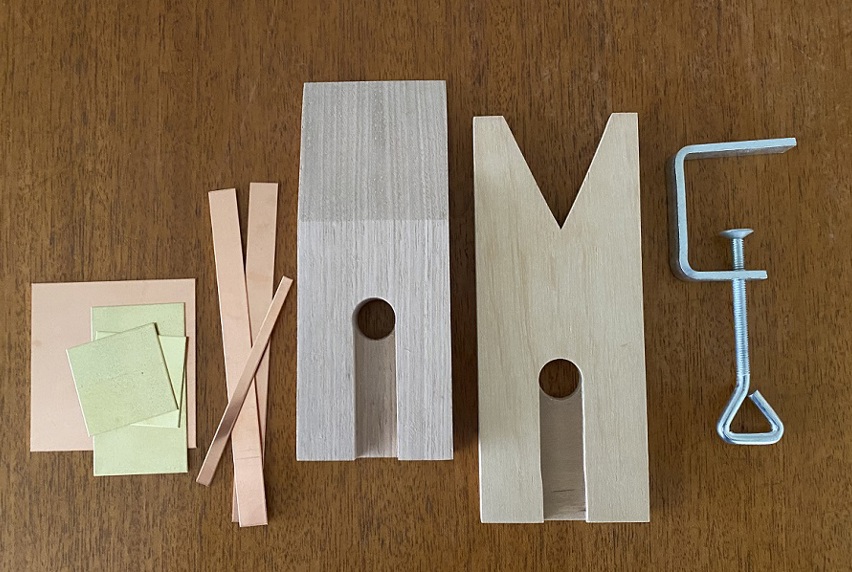Jewellery teacher Gary Swift gets creative with timber

This is it! the world-famous Melbourne Polytechnic annual Jewellery and Object Design auction is officially open for bids.
Our current environment has moved the extravaganza online, so the Advanced Diploma students of the Jewellery and Object Design program have created a dedicated website to get the bidding action going.
Final year students and established artists have lovingly crafted 60 pieces for the sale, which is held to raise funds for staging the students’ graduate exhibition.
And among the necklaces, rings, earrings, pendants, brooches and bangles is a piece of furniture, a jewellery bench handcrafted by jewellery teacher Gary Swift.
The jeweller’s bench is the place where they work their magic, transforming metals and stones into pieces of art. This bench enables an artist to work from home on a setup just like they have in a workshop.
It features a curved cutout so the jeweller can lean over the work and use tools, a tray to catch the precious off-cuts and filings for recycling and a bench peg, a small but crucial bit of kit.
The bench peg’s protruding position allows for maximum movement of tools around the piece and also helps to steady hands and tools to ensure delicate, intricate work can done with care and precision.
As Gary explains: ‘When you're working in non-ferrous and precious metals, they're relatively soft and therefore easily damaged. If you put anything made of precious metals or non-ferrous metals in a vice the material takes on the texture of the jaws of the vice. Same rule applies if you pick up a pair of handyman pliers, the pliers leave teeth marks all over the material.
‘The magic of jewellery-making is can you take a piece of material and manifestly change its shape but leave it with the appearance that you've not ever made contact with it. That’s really the magic of jewellery making and that begins very simply with the bench peg.’
Gary, who has taught jewellery at Melbourne Polytechnic for 14 years, has found himself doing a lot of woodwork since the pandemic began. He realised that when access to the campus workshops was restricted, the students would want and need to continue their creative work from home.
Having a bench peg that they could clamp on to an existing piece of furniture at home meant they could keep on creating, so he made bench pegs and put them in a pack with a clamp and some brass and copper materials and sent them to students.
He also heard about a second-year student going into the first lockdown who was very concerned that she didn't have a workbench at home. Gary made her one by taking an existing piece of furniture and reworking it by making it taller, cutting the distinctive circular shape and adding the peg.
Gary also made 28 social distancing screens for the jewellery workshops at the Fairfield campus. The benches there were too close together to abide by the rules but are bolted to the floor, so the screens went up as a temporary measure. They look like they might be there to stay for a while.
The jewellery teaching team has risen to the challenge of adapting in a pandemic.
‘I know that Melbourne Polytechnic's working very hard to put together online teaching for students,’ he says. ‘For me it was about what can I do in a practical way to assist?’ Cue the creation of screens, pegs and benches.
‘There's regular communication with the students via email and/or Zoom. Without there being formal workshop classes we're in communication with the students and theory classes are now being managed online.
‘I get phone calls and emails often asking questions. I get photographs from time to time - students will send me things that they currently making and need advice.
‘I decided I would make a workbench which seemed to fit into the business of teaching and of what people might be doing in their own space and what they might be doing into the future after they finish with us. That just seemed like a good idea.’
Gary says he learned the basics of his woodworking skills back in the day at Heidelberg Technical School (coincidentally now a Melbourne Polytechnic campus) and honed them with his own home renovations.
He’s been a teacher of jewellery and sculpture for about 40 years. ‘I did a four-year apprenticeship in the jewellery trade, a three year diploma of gold and silversmithing at RMIT post my apprenticeship and worked in the jewellery trade for a time,’ he says. He also taught jewellery making at the Centre for Adult Education before the move to Melbourne Polytechnic
Bids for the auction start Wednesday 2 September at noon and close Wednesday 9 September at noon.
